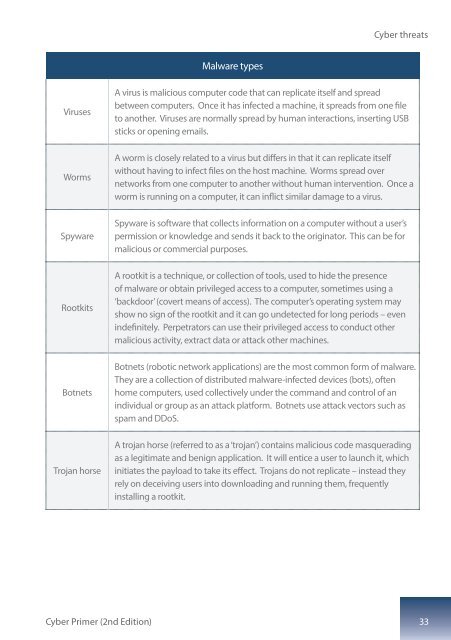Cyber Primer
AEWhbF
AEWhbF
Create successful ePaper yourself
Turn your PDF publications into a flip-book with our unique Google optimized e-Paper software.
<strong>Cyber</strong> threats<br />
Malware types<br />
Viruses<br />
A virus is malicious computer code that can replicate itself and spread<br />
between computers. Once it has infected a machine, it spreads from one file<br />
to another. Viruses are normally spread by human interactions, inserting USB<br />
sticks or opening emails.<br />
Worms<br />
A worm is closely related to a virus but differs in that it can replicate itself<br />
without having to infect files on the host machine. Worms spread over<br />
networks from one computer to another without human intervention. Once a<br />
worm is running on a computer, it can inflict similar damage to a virus.<br />
Spyware<br />
Spyware is software that collects information on a computer without a user’s<br />
permission or knowledge and sends it back to the originator. This can be for<br />
malicious or commercial purposes.<br />
Rootkits<br />
A rootkit is a technique, or collection of tools, used to hide the presence<br />
of malware or obtain privileged access to a computer, sometimes using a<br />
‘backdoor’ (covert means of access). The computer’s operating system may<br />
show no sign of the rootkit and it can go undetected for long periods – even<br />
indefinitely. Perpetrators can use their privileged access to conduct other<br />
malicious activity, extract data or attack other machines.<br />
Botnets<br />
Botnets (robotic network applications) are the most common form of malware.<br />
They are a collection of distributed malware-infected devices (bots), often<br />
home computers, used collectively under the command and control of an<br />
individual or group as an attack platform. Botnets use attack vectors such as<br />
spam and DDoS.<br />
Trojan horse<br />
A trojan horse (referred to as a ‘trojan’) contains malicious code masquerading<br />
as a legitimate and benign application. It will entice a user to launch it, which<br />
initiates the payload to take its effect. Trojans do not replicate – instead they<br />
rely on deceiving users into downloading and running them, frequently<br />
installing a rootkit.<br />
<strong>Cyber</strong> <strong>Primer</strong> (2nd Edition) 33


